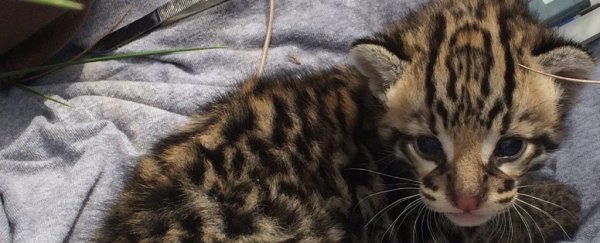Scientists have spotted two litters of ocelot kittens in conservation ranges in Texas, a sign that these rare wild cats could be poised to thrive again in the Lone Star State.
While South and Central America have healthy populations of ocelots, less than 100 are believed to still live in Texas, with over 95 percent of their original habitats now cleared for farming or building, and traffic accidents a constant threat.
To get a better handle on the ocelot population, biologists from the US Fish and Wildlife Service (USFWS) used secret camera traps and GPS technology to track female ocelots across two conservation areas – the Yturria Conservation Easement and the nearby Laguna Atascosa National Wildlife Refuge.
"[At the easement], we detected three mums with litters, and one of those mums had twins, which is not typical and was incredibly exciting for us," USFWS wildlife biologist Hilary Swarts told Alexandra Petri at National Geographic.
 Credit: USFWS
Credit: USFWS
To the south in the main refuge, Swarts and her colleagues discovered an actual ocelot den, the first spotted in this conservation area in nearly 20 years.
Inside the den was a three-week-old male kitten weighing 400 grams. USFWS experts gave the baby a quick health check before the mother returned, and will be keeping a close eye on him in the future.
According to the GPS collar on the kitten's mother, this was the second den site used by the same ocelot – a fairly typical scenario, as ocelots are thought to move their dens around to evade both predators and infestations from fleas and ticks.
With five kittens now spotted, the animals could potentially be making a comeback in the area, with abundant rainfall and subsequent plant growth over recent years helping to explain the rebound.
That plant growth provides food for the rodents, rabbits, and birds that ocelots rely on as part of their diet.
"With plenty of food and water, and minimal disturbance from humans, female ocelots have all the resources they need to reproduce successfully," says Swarts.
And steps are being taken to cut down on human disturbance, with the Texas Department of Transportation (TxDOT) installing a dozen highway underpasses earlier this year to keep the wild cats out of the traffic.
That's more important than you might think: two years ago, road accidents were the number one cause of ocelot deaths in the United States.
When an ocelot population becomes smaller and more spread out, the animals need to travel to find mates, and that means crossing roads and interacting with humans.
 Credit: USFWS
Credit: USFWS
The measures seem to be working so far: four out of the seven female adult ocelots known to be in the Laguna Atascosa refuge have now been seen with kittens, and while the animals aren't on the endangered list as far as the global picture goes, it's fantastic (and pretty cute) to see them holding on in the southern US.
But the USFWS needs help to keep the good work going – not only from land donations like the Yturria Conservation Easement, but also from ocelot sightings reported by the public.
"What was so great with seeing the burst of kittens this year… [is that] they're doing their job, which is to produce more ocelots," says Swarts. "We have been making some good strides as far as reducing threats."
Finally something to smile about in 2016.
